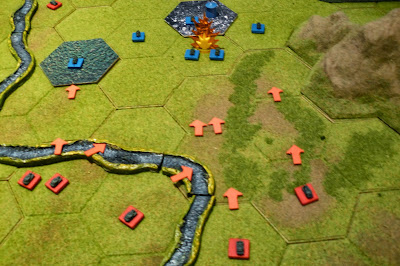After an uninterrupted 16 years of presenting participation games at CRISIS, we decided for our 17th game to try something new: a mass participation wargame, run in real-time. Our goal is to have as many players as possible to participate in the game, each with a limited micro-order. The accumulation of all these micro-orders will result (hopefully) in a full game, resolved by 17.00.
The design philosophy of this game will be kept for a future blogpost. This post will explain the playing principles, such that players can prepare themselves to participate in this experiment.
The game features a modern land war between Red and Blue.
The cards
We have printed roughly 1200 (twelve-hundred) playing cards, each containing a single gaming action for either Red or Blue. These cards will be dealt out en masse in the convention hall, with the explicit task to go to the game at any time during the day. So, spot a Schild&Vriend club member wandering the convention hall and get a card!
Cards come in different variations: movement and attack orders, reinforcements, airstrikes, etc. Some uncommon cards specify weather effects. Some cards allow you to play interrupts during the other side's turn. Some ultra-rare cards allow you to play nuclear strikes.
The clock
When you arrive at the gaming table, take a look at the real-time clock (prototype shown below). When the minute hand is in a red sector - colored sectors last for 10 minutes - cards for Red can be played. The more players show up for Red, the more cards can be played, and the more orders Red can execute. During this phase, orders are only planned and represented visually on the table - but are not yet executed. Execution follows when the minute hand enters a black sector. No more orders for Red can be played at this time. After 5 minutes of execution time, the cycle is repeated for Blue.
Planning
Below is an example of what the planning phase might look like. The example is rather small and limited, since the gaming table will be several times larger than what is shown in the photographs. The scale of the game is more akin operation Barbarossa rather than a skirmish fight.A situation at the start of Reds's cycle is shown below. Blue defends one of its cities. Imagine each hex being 10km across and each tank represents a division. The game is played at a strategic scale!
It is Red's planning turn, and the first player plans some movement orders. These are indicated by arrows. One arrow moves one division one hex. Keep in mind that no movement is yet executed.
More players for Red show up, playing additional movement orders. A movement order into an enemy-occupied hex counts as an attack.
Another player plans an airstrike just in front of Blue's city. Planned airstrikes are indicated by explosion markers.
... and even some more movement/attack orders are laid down. During executuon, units will start using up movement orders, and will keep moving as far as they can. That's why it is important to have as many players as possible supporting Red at the table as possible. Players supporting Blue will be able to play interrupt cards with weather effects such as rain, clouds, fog etc.
A rare card has shown up! A nuclear strike is planned! In the distance, some other weather effects such as a rain storm are also visible.
Execution
When the minute hand enters a black sector on the clock, time's up and now is the time for execution! Red's units start "eating up" movement orders, one order for one unit that moves one hex. The situation below shows the executed movements just before the attacks are rolled for (simple D6 mechanisms). The actual rules governing combat are literally only 10 lines long, and will be explained by the game controller at the table when necessary.... and this might be the situation after combat resolution. Attacks that succeeded result in Red units occupying previously enemy-held hexes.
Of course, the game will see many more players participating over the entire breadth, width and depth of the playing field. The idea is that visually, one sees a big planning map that should give you the feeling of planning a war in a situation room. When the clock hits a black sector, one of the game controllers will resolve all actions, the visual planning markers are removed, and the other side takes a turn.
The game starts at 10.00, and will play continuously till approximately 17.00.
Will Red be able to conquer the Blue homelands? Come and find out at CRISIS 2013!!!
Note: Hex terrain from Kallistra, explosion and weather markers from Litko, cards printed by The Game Crafter.












Seems promising if visitors are participating "en mass". Count on me.
ReplyDeleteYou have a best participation game winner !
Benoit
ziet er inderdaad heel cool uit
ReplyDeleteIk doe zeker mee, onder voorbehoud dat ik minstens een kaartje bemachtig!
ReplyDelete